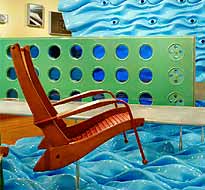
University galleries may not enjoy the highest profile in this city, where institutional Goliaths tend to suck up all the oxygen. But their curators often manage to present—on limited budgets in small spaces—tightly focused shows with drop-dead thinking and edgy work. Under the direction of architect Evan Douglis, Columbia University’s Arthur Ross Gallery has regularly mounted provocative, idea-driven shows, and its current exhibition, Jean Prouvé: Three Nomadic Structures (running through April 23, 2004), is no exception. This well-established venue in the Columbia architecture school now enjoys the academic company of newcomer Pratt Manhattan Gallery on West 14th Street. In the past year, the Pratt’s director, Loretta Yarlow, has produced a string of probing shows, including the recent one devoted to Vito Acconci, the New York high-wire performance artist who, during the past decade, has crossed over into performance architecture without benefit of a net.
No New York show has presented the evidence of architecture’s shift from a mechanical to a digital design paradigm more graphically than “Nomadic Structures.” Digital technology has challenged and inspired the field—to the point of identity crisis. Co-curator Robert Rubin lent furniture, vintage photographs, and architectural parts from his own collection of artifacts produced by Prouvé, the legendary mid-century French architect. Several modular doors, soffits, easy chairs, and grammar-school desks, made of bent metal frames and wood, document the work of an architect who pursued industry’s potential for housing and furnishing the world through the logic and economies of factory production.
While his compatriot Le Corbusier sculpted forms inspired by evocative mud-packed buildings that he discovered in Saharan Africa, Prouvé was advocating nomadic architecture for African states, modular houses that could be shipped, erected, dismantled, and shipped again like so many Tinker Toys. Prouvé manufactured the components of his furniture and houses from a detailed understanding of fit, connections, materials, and the conveyor belt.
Fascinated by automobile and aeronautical technology, Prouvé would certainly have embraced the architectural application of computers in the design of cars and planes. Indeed, Douglis here created the modular pieces of a background that is demountable, remountable, and eminently transportable: This show could travel. Its surface of turbulent waves, sprayed with twelve coats of turquoise automobile paint, floats the eye up to artifacts lifted in moments of repose above the sea of intensity. A leader in the application of computer technology to architectural design, Douglis has moved beyond the white box, inventing new ways to showcase objects. Clarifying the designer’s work, the installation is as interesting as the exhibits it supports: Douglis is channeling Prouvé.
Vito Acconci, long a creature of the galleries in which he staged sometimes outrageous performance pieces, has migrated in the other direction, practicing art as architecture. Acconci Studio: Slipping Into the 21st Century (closed) documented well over a dozen environmental projects that trace Acconci’s brand of conceptual art. One of the most recent is a voluminous, translucent structure made up of a convex shell curving into a concave form, all floating in the middle of a river flowing through Graz, Austria. A fantastical event in the landscape, it serves as a café and general all-purpose hangout.
Acconci is certainly influenced by the logic, developed so clearly in the Columbia show, of the computer. But he is much more interested in the expansive, inhabitable spatial gesture than in any thesis about surface. Acconci (also the subject of a show at Schachter Gallery in Greenwich Village) has developed a spatial sense that is highly three-dimensional without dulling his edge—as demonstrated by his almost shocking proposal for the World Trade Center site. The Pratt installation, with swirling veils of translucent fabric supported on curving floor-to-ceiling wire armatures, illustrated how artists and architects are making real the flowing spaces and forms now being visualized onscreen. In the installation, Acconci literally pushed the envelope into billowing floes that waltzed visitors through space.